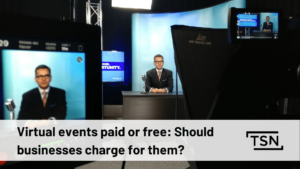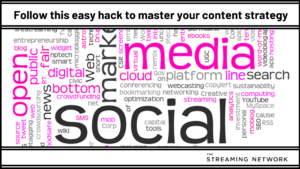You can attain a higher return on investment (ROI), reach a larger audience, and convey more information across your entire viewership with one change.
By implementing hybrid events.
What Is A Hybrid (Webcast) Event?
It is the combination between an in-person event, like a conference, merged with a live webinar or webcast.
Conferences can be a great way to network, however, think about the last conference meeting you attended and the costs. Some of these expenses may have been the following:
- Travel/gas.
- Accommodation (example: hotel fees).
- Most importantly, your time.
Live hybrid events are a great way to accommodate potential attendees who cannot make it to your in-person event due to certain circumstances (eg. restricting schedules, traveling from another city/country, etc).
If these costs and restrictions deter some of your conference attendees, implementing a virtual element would bring them back.
Ask yourself this, if you had the option of watching your next conference meeting online and on your own time, would you do so?
If you answered yes, then continue reading to learn how to launch a successful hybrid event, and dispel some of the common myths associated with them.
Launch A Successful Hybrid Event
While your speakers or presenters are getting ready for the in-person event, you should have a webinar expert managing your virtual presentation.
This includes ensuring that you have a strong internet connection. The last thing you will want is for your live event to start buffering in real time – any potential leads will leave during this time and it will be hard to bring them back.
Do your microphone checks. More often than not, they might be out of batteries and that would be better to find out before your event. This includes an audio check to ensure there is no feedback or any other sound issues.
Have you ever had to run your own presentation in a meeting and struggled with the slides or technology? Do a quick run-through of the event if possible. This will flag any potential problems that you can solve before going live.
Ensure that you are interacting with your webinar attendees as usual. Leverage tools like Live Q&A, polls, surveys, and more to keep your virtual audience engaged.
Common Myth About Hybrid Events
A common myth about hybrid events is the concern that one’s conference attendance will go down once they add a virtual layer to it.
The attendees who come out to your physical events are different from your webinar viewers. The former belongs to a group that is invested in the content you are conveying. This could be in the form of educational seminars to employees or new content for prospective clients and stakeholders. They are making the journey to see you face-to-face because they value what you are offering them.
Webinar attendees, however, are less invested in your physical event. These might be potential leads that are just learning about your company and what you are offering. Right now, they are in the Top Of The Funnel Stage (brand awareness).
As such, they are less willing to come out to your conference or seminar. That being said, adding a virtual layer widens your viewership net as you are now able to reach a whole new audience. Your overall event attendance will go up because you will be leveraging two tools to reach more people.
The additional benefit is that if you are able to capture the interest of your virtual attendance, your webinar attendees can potentially convert into conference attendees. Giving them the ability to speak to your presenters.
Increase Event ROI
Hosting a live virtual webcasting event opens the door to international stakeholders – another way how you could be expanding your viewership and increasing your ROI.
Planning for a physical event can be expensive once you account for the aforementioned costs as well as guest speaker fees. By adding a virtual component, you will be effectively lowering your cost per head, thus lowering much of your expenses.
Read our post here for a refresher on increasing your ROI through webinars.
Incorporate On-Demand Webinars
The reality is that stakeholders, such as your employees and prospective leads, are becoming busier.
We previously discussed the benefits of including on-demand webinars to your content strategy. The same logic applies here.
You will have webinar registrants who will be interested in your event, but do not end up attending due to things like, changes in their work schedule. Offer your hybrid event as an on-demand webinar to unlock another potential viewership group. By doing this, you will have effectively increased your total viewership against the number of in-person attendees to your physical event while keeping overhead costs down.
Let’s Recap
Hybrid events are a great way to reach new audiences and increase your webinar ROI by adding a virtual element to your in-person events.
To launch a successful hybrid event, make sure that you:
- Have a strong internet connection. You want to avoid any buffering during your live webinar.
- Do a sound check. Ensure your microphones are charged and are not giving off feedback.
- Overall, do a quick practice round of your event to find any potential setbacks that you can solve before going live.
Adding a virtual layer to your conference will bring more attention to your event by allowing people who physically cannot attend to consume your content.
Virtual viewers have a lower cost to you and so you can focus your efforts on increasing your revenue which will increase your overall webinar ROI.
Lastly, by incorporating on-demand webinars, you will be able to access a bigger market of viewers who can consume your content at their own leisure.
Stay tuned for next week for a new vodcast episode on Lessons On The Frontline.






